For the past three years, I have had a pine warbler Setophaga pinus show up at the feeders at the end of April, almost to the day. At first glance, these birds can be mistaken for American goldfinches Spinus tristis, or other types of warblers. This pine warbler is a male and will only stay around for a couple of days and then it is gone. I’m not sure if this bird stays in the area for the spring and summer or continues to migrate elsewhere. This year, I was able to take a few photographs before he disappeared. We have been experiencing a lot of rain and cloudy days here in Maine and I was hoping for brighter images of this bird, but I suppose I can’t control these things. I would like to share some information and a few facts about these fascinating songbirds, as well as a few resources for aiding in their identification..
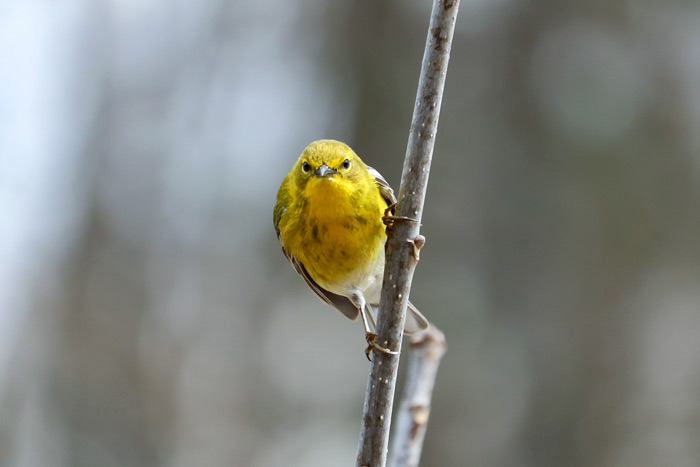
A pine warbler looking at the camera.
During spring migration, warblers are some of the most exciting birds to view for bird watchers and photographers alike. Most warblers do not visit bird feeders and will remain in the woods. Most members of this family are insectivores. There are always exceptions and if you are fortunate enough, you may have a few of these visitors at your feeders as well. My pine warbler visitor usually enjoys the suet I had put out. I recently put two types of suet out for the birds to enjoy. The first is Audubon Park nut and mealworm suet and the second is Royal Wing sunflower suet.
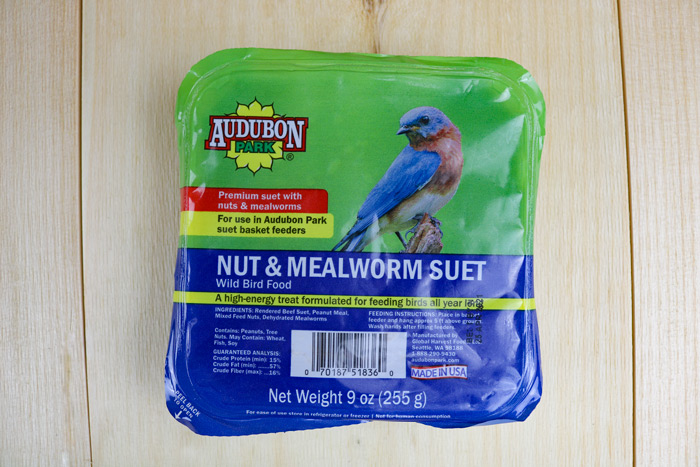
A package of nut and mealworm suet.
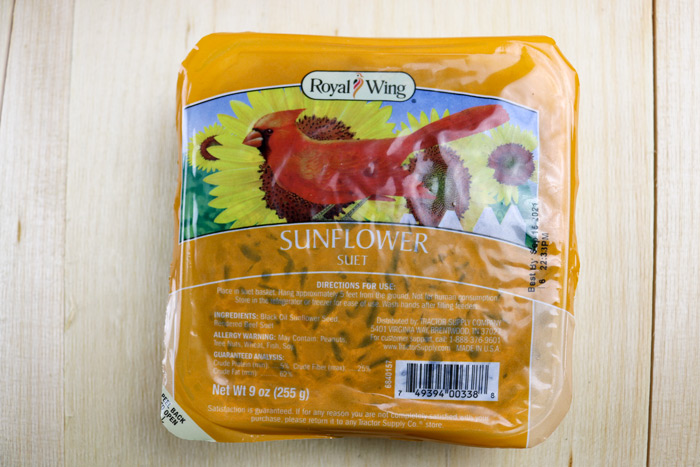
A package of sunflower suet.
Warbler Identification
The pine warbler belongs to the New World warblers or wood-warblers. There are over fifty species of warblers in the United States and Canada. These birds are brightly colored passerine birds that make up the family Parulida. Correctly identifying warblers can be quite challenging, even to the most avid birder. There are many field guides and online resources available for helping viewers correctly identify these birds. Warblers are small and move quickly and viewers need to be prepared for proper identification. In the field, bird watchers have to learn to look for key characteristics and field markings. Before going out, viewers should be equipped with the proper tools for identifying warblers. In regard to field guides, I would recommend The Warbler Guide by Tom Stephenson and Scott Whittle. This is an informative guide and will help you identify warblers and it focuses on key points for teaching species identification. Among the countless websites online, I like warbler identification tips provided by The Spruce. Also, if you are interested, there are online courses available. For example, Cornell offers through the Cornell Lab Bird Academy a Be a Better Birder: Warbler identification course. Cornell sends me frequent emails about this course offering. I believe the course costs $124.99, but they are currently offering it for $99.00. Once you feel comfortable with your identification skills, make sure to get outside, and practice identifying and enjoying these birds.
Pine Warbler vs. American Goldfinch
As I mentioned above, at first glance after seeing a flash of yellow, I thought the pine warbler I had seen was an American goldfinch. After getting a better look, I knew exactly what type of bird I was viewing. Here is a description of both of these species regarding color, for better identification. Pine warblers are yellowish in color with olive backs. Adult males are the brightest and the females and immature birds are duller. During the spring, male American goldfinches are a brightly colored yellow with a black forehead, and black wings with white markings. Adult females are duller yellow beneath and olive above. The pine warbler and American goldfinch, both have white tail spots, but in the warbler, they are on the two outermost tail feathers, while all are spotted on the goldfinch. During winter, the American goldfinch’s rump and belly are mostly white, while in a pine warbler only the belly is whitish. The pine warbler and American goldfinch both have white tail spots, but in the warbler, they are on the two outermost tail feathers, while all are spotted on the goldfinch. Pine warblers have whitish bellies and two prominent white wingbars on gray wings. Also, pine warblers don’t show the strong patterns that other types of warblers have, but the face can look weakly “speckled,” with a pale eyering connected to a pale stripe in front of the eye.
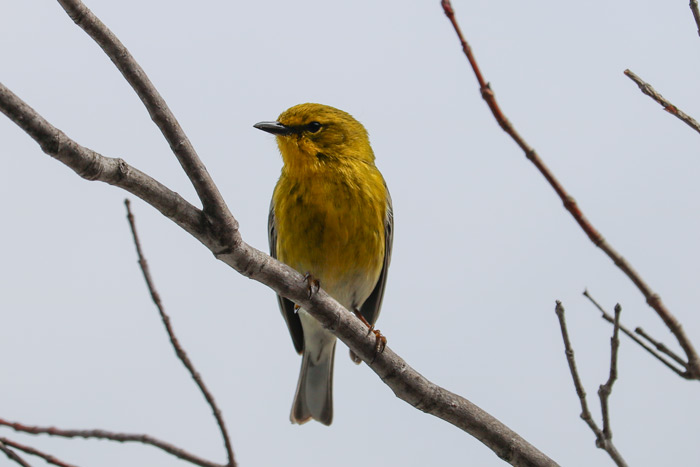
A male pine warbler.
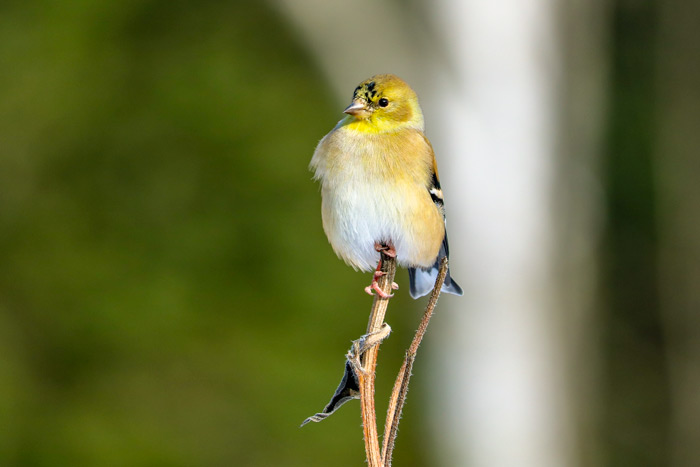
A molting male American goldfinch perching on a dried sunflower stalk.
The Female Pine Warbler
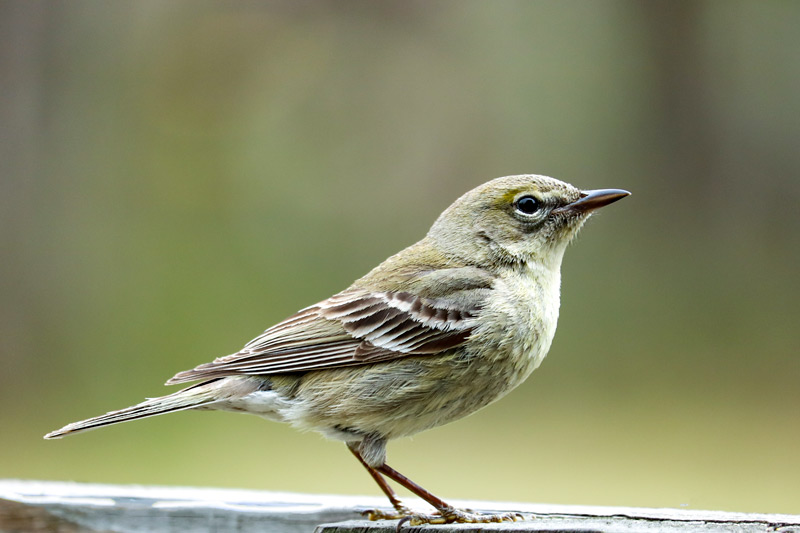
Females and immature pine warblers have softer coloring than males and can even appear gray-brown in color.
Pine Warbler Size & Shape
Pine warblers are large, long-tailed warblers with substantial bills. The tip of the tail will usually have a central notch.
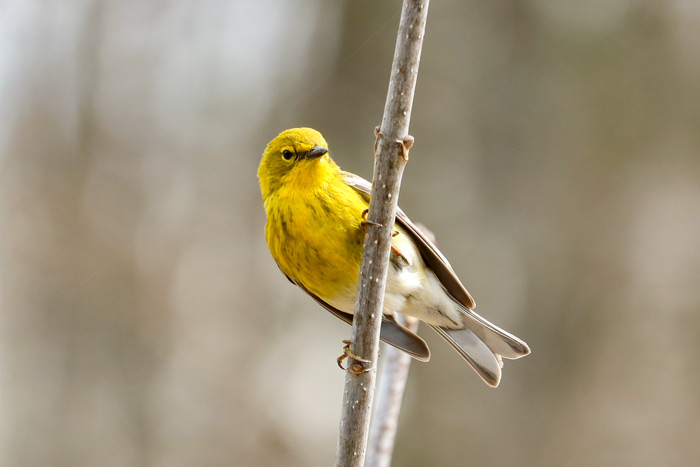
A pine warbler showing its underside.
Pine Warbler Behavior
True to its name, the pine warbler is found in open pine woods and pine barrens, especially during the breeding season. In winter, the pine warbler expands its territory to include orchards, thickets, mixed deciduous, pine woodland edges, bottomland forests, and backyards, where it is not hesitant to come to bird feeders to eat seeds and suet.
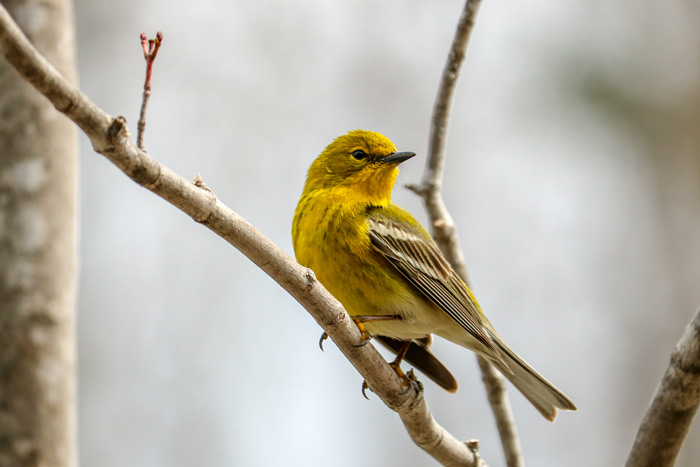
A pine warbler perching on a branch.
Pine Warbler Diet
A considerable amount of the pine warbler’s diet consists of insects and spiders, as well as grasshoppers, caterpillars, moths, beetles, and ants. These birds also eat fruits and seeds. During the colder months, they will consume pine seeds. They will also visit bird feeders looking for suet and seeds. I will mention other food sources below as well.
Pine Warbler Call
Both males and females make sharp, short call notes. The males and possibly the females will use a rattle call for territorial defense and other aggressive encounters.
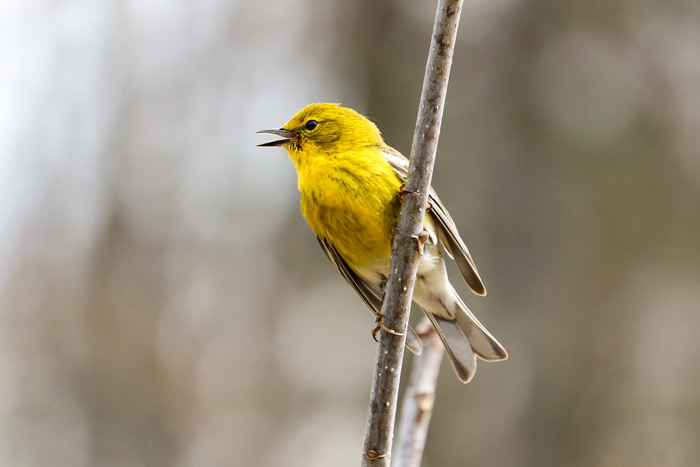
A singing male pine warbler.
Pine Warbler Song
The pine warbler may sing anytime during the year. Males will sing from high branch tips of pines and usually sing while foraging or during the breeding season. The pine warbler’s song is a loose trill, similar to the notes of a chipping sparrow (Spizella passerina) and dark-eyed junco Junco hyemalis, but slower, richer, and more musical.
Pine Warbler Nesting
Nesting sites are located toward the end of the limbs of pines and sometimes other trees. The nests are usually built by the female. Nests consist of a deep and open cup of weed stalks, grass stems, strips of bark, pine needles, twigs, and spiderwebs that are lined with feathers.
These birds have three to four eggs that are off-white, with brown speckles toward the large end. The eggs are incubated by both parents for about ten days.
Both parents bring food to their young. Young leave the nest at ten days of age. Pine warbler pairs may raise two to three broods annually.
Pine Warbler Migration
The pine warbler is considered to be a partial migrant. Northern pine warblers in the United States will migrate to the Southeast. The pine warblers that breed in the Southeast will typically stay year-round.
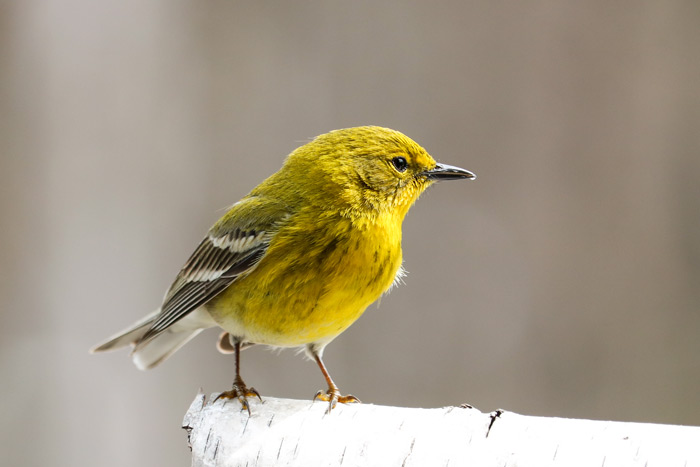
A side view of a pine warbler perching on birch.
How to Attracting Pine Warblers to Your Yard
If you would like to attract these birds to your own yard, try providing a few of these food sources. Pine warblers are the only warblers that will regularly eat seeds. They also eat millet, cracked corn, sunflower seed, peanuts, and suet from elevated feeders during the winter months. These birds may also eat fruits from bushes and vines, like bayberry, flowering dogwood, grape, sumac, persimmon, and Virginia creeper.
Thank you for reading and I hope you enjoyed learning about these extraordinary warblers.
Resources used for this post:
allaboutbirds.org & audubon.org
Leave a Reply